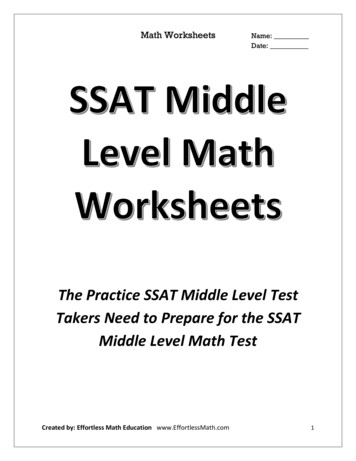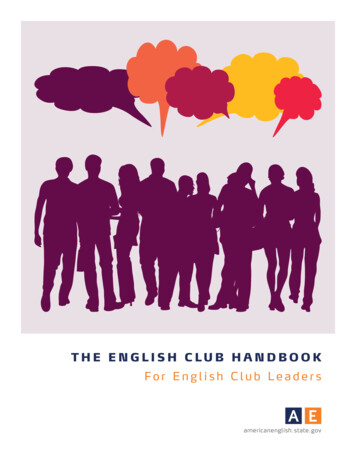
Transcription
EFFORTLESSENGLISHLEARN TO SPEAK ENGLISH LIKE A NATIVEA.J. HOGE
Effortless English is published by Effortless English LLC1702 A. Street, Ste. CSparks, NV 89431Inquiries: events@effortlessenglishclub.comWebsite: www.effortlessenglishclub.comCopyright 2014 by Effortless English LLC and A.J. HogeAll rights reserved.ISBN: 978-1-942250-00-5LCCN: pendingLibrary of Congress Cataloging-In-Publication Data Has Been Applied ForCover design and typesetting: Enterline Design Services LLCNo part of this publication may be reproduced, stored in, or included in a retrieval system, ortransmitted in any form without the prior written consent of the publisher. Your support ofthe author’s rights is appreciated.
EFFORTLESSENGLISHLEARN TO SPEAK ENGLISH LIKE A NATIVE
ContentsChapter 1: A Better Way to LearnEnglish . . . . . . . . . . . . . . . . . . . . . . . . 7Chapter 2: The Problem with Schools . 17Chapter 3: Psychology Is MoreImportant Than Grammar andVocabulary . . . . . . . . . . . . . . . . . . . . 27Chapter 4: Your Beliefs DetermineYour English Success. . . . . . . . . . . . 37Chapter 5: English Is A Physical Sport . . . . . . . . . . . . . . . . . . . . . . . . . . . . . . 43Chapter 6: Use Big Real World GoalsTo Motivate Yourself For Success . 51Chapter 7: Program Your Brain ForEnglish Success . . . . . . . . . . . . . . . . 57Chapter 8: Babies Learn Best — TheEffortless English Engine . . . . . . . 67Chapter 9: The First Rule – LearnPhrases Not Words . . . . . . . . . . . . . 71Chapter 10: The Second Rule:Grammar Study Kills Your EnglishSpeaking . . . . . . . . . . . . . . . . . . . . . . 79Chapter 11: The Third Rule: LearnWith Your Ears, Not With Your Eyes. . . . . . . . . . . . . . . . . . . . . . . . . . . . . . 87Chapter 12: The Fourth Rule –Repetition Is The Key To SpokenMastery . . . . . . . . . . . . . . . . . . . . . . . 99Chapter 13: The Fifth Rule: LearnGrammar Intuitively AndUnconsciously . . . . . . . . . . . . . . . . 107Chapter 14: The Sixth Rule: Learn RealEnglish And Trash Your Textbooks . . . . . . . . . . . . . . . . . . . . . . . . . . . . . 117Chapter 15: The Seventh Rule: LearnEnglish With Compelling Stories 127Chapter 16: Your Daily EnglishLearning Plan. . . . . . . . . . . . . . . . . 137Chapter 17: The Power of PleasureReading . . . . . . . . . . . . . . . . . . . . . . 145Chapter 18: The Secret To GoodEnglish Writing . . . . . . . . . . . . . . . 149Chapter 19: Why You Should NotPractice Speaking . . . . . . . . . . . . . 157Chapter 20: English Is The Language OfInternational Business . . . . . . . . . 165Chapter 21: How To Give PowerfulEnglish Presentations . . . . . . . . . . 169Chapter 22: English Connects YouWith The World . . . . . . . . . . . . . . . 177Chapter 23: The Effortless English Code and Mission . . . . . . . . . . . . . 183About the Author . . . . . . . . . . . . . . . . 191
CHAPTER 1A Better Way to Learn EnglishIf you’ve picked up this book, chances are you’ve wanted to speakEnglish for a while. Maybe you’ve even taken classes. You probably needEnglish to improve your career. Maybe you want to travel internationally or study abroad. You know that English is the key to internationalbusiness and international travel. So let me ask you something.Do you feel nervous or shy when you try to speak English? Doyou still struggle to understand what someone is saying to you despite years of study? Are you embarrassed about your pronunciationor worried you speak too slowly? Are you frustrated that despite allthe time you’ve invested in learning English you still can’t speak it?Despite your goals, is it difficult for you to actually use English in yourjob, travels, or studies? Do you sometimes feel that you’ll never masterspoken English?If you answered yes to any of these questions,you’re not alone. In fact, you’re fairly typical. MostEnglish students feel this way. Most adult English learners are stressed and frustrated abouttheir speaking ability. Some feel completelyhopeless and feel they’ll never be able tospeak English powerfully. Not becausethey’re bad at languages, but because, likeyou, they’ve been taught using the wrongmethods.
8 Effortless EnglishThe good thing is that it doesn’t have to be like this. There is nothingwrong with you. You can learn to speak English naturally and withease. You can use English effectively in your job, travels, and studies.You can feel relaxed and confident every time you speak English. Infact, as a long-time English teacher, I’ve helped thousands of studentsall over the world become fluent and powerful English speakers.How did I do it? I did it using a teaching method I developed calledEffortless English . Effortless English enables you to learn Englishnaturally and automatically – the way children learn before they enterschool. Too often, English classes get so focused on tests, textbooks,grades and “levels,” students forget why they’re there in the first place.They forget about the real world goals of a more successful career andexciting international travel. With Effortless English you never losesight of the fact that the ultimate goal of learning a language is communication. Instead, you learn to speak English both quickly and withmore precision.Effortless?I understand if you’re skeptical – particularly if you’ve been trying tolearn English the traditional way. You’ve put in the hours: memorizing vocabulary lists, doing grammar drills, reading boring textbooks.“How?” you’re thinking, “can speaking English possibly be effortless?”Believe me, I feel your pain.Back when I started teaching 15 years ago, my students were all excited to begin conversing in English. And I was excited to help them.At that time, I taught in the usual way. I used textbooks and I focusedon teaching grammar. I thought this was the best way to teach, andnone of my students complained.
9I still remember one particularly intelligent student of mine fromVenezuela named Gladys. Gladys was determined to speak Englishwell. Talk about effort! Gladys attended every one of my classes. Shealways sat in the center of the front row. I can still picture her eagerand smiling face. She took detailed notes. She listened to every word Isaid. She also studied at home. Every day Gladys studied her Englishtextbooks for four hours or more. She also tried to learn 50 new vocabulary words by memorizing word lists. Gladys was my star studentand I, too, was sure she would succeed.Six months later, however, she still could barely speak English. Herspeech was hesitant and unnatural. She constantly made grammarmistakes with even the simplest sentences. Her pronunciation was difficult to understand. She still thought in Spanish and tried to translateto and from English when she spoke. Worst of all, Gladys felt nervousevery time she tried to speak English. Speaking English was a painfulexperience for her.Gladys was extremely frustrated. After so mucheffort, she had barely improved. As her teacher,I too was frustrated. I was sure Gladys wouldimprove quickly and couldn’t understand why she had not. I followed allof the traditional teaching methods.I used the standard textbooks and thestandard classroom activities. Gladyswas intelligent, disciplined and consistent,and yet her English speaking barely improved.Sadly, I realized that Gladys wasn’t the onlyone who had not improved. Her classmates
10 Effortless Englishalso had barely improved. It was frustrating, and I felt like a completefailure as a teacher. But when I asked my colleagues for help, it turnedout they had the same problem – very few of their students were improving either! At that point, I realized something was wrong – something is wrong with standard methods for teaching English. The worstpart for me was that everyone accepted this situation as “normal.” Theother teachers didn’t seem to be concerned about their students’ lackof progress. All the teachers were using the same methods and gettingthe same poor results.In most parts of the world, students study English in school foryears. Yet, the vast majority of them never learn to speak English well.After years of study, they still have trouble with real English conversations. They still feel nervous and shy about speaking.A few years after my experience with Gladys, I got a job as an Englishteaching assistant in Japan. I was excited and eager to help these youngstudents learn my language. I still remember my first day. I was sittingat the front of the class next to the main teacher, who was Japanese. Asthe students came into the room, they saw me and giggled nervously.They sat down and continued to shyly glance up at me. They weresweet and curious.Then the class started. The main teacher wrote an English sentenceon the board. I don’t remember the exact sentence, but it was something like, “The little girl goes to school.” The teacher pointed to thesentence and began to talk in Japanese. The students all grabbed theirnotebooks and began writing. Everyone was very serious.Next, the teacher circled the word “goes.” She pointed at the wordand continued speaking in Japanese. She talked and talked and talked,in Japanese. The students wrote quickly, filling their notebooks with
11information. Finally, the teacher drew a line from the word “goes”to the word “girl.” And then she talked more, on and on and on, inJapanese.This continued for the entire class. The teacher drew lines, circles, andsquares. She used different colored chalk. And she continued speakingJapanese.I was totally confused. I am a native speaker of English, and I wassitting in a beginning English class. Yet I could not understand anything in the class (except for that one sentence). I was thinking tomyself, “What could this teacher possibly be talking about so much?It’s just one sentence.” Yet the teacher spent an entire hour analyzing,explaining, and dissecting that one simple sentence. Finally, at theend of the class, the teacher asked me to read the sentence aloud “forpronunciation.” I read the sentence a couple of times, and that was theonly real English input the students got that day.Sadly, this same pattern repeated every day. Day by day, I watchedthe students’ enthusiasm and curiosity disappear. They became bored.They became stressed and confused. Every day they wrote pages ofnotes, mostly in Japanese. Every day the teacher talked and talkedand talked, mostly in Japanese. I couldn’t understand why an Englishclass was being taught mostly in Japanese. During the average class,the students were listening to Japanese 90% of the time or more. Theyheard very little English. No wonder they never learned to speak! Nowonder they were frustrated and confused.Honestly, it broke my heart to watch as the school crushed thesestudents’ natural love of learning. It was terrible to watch them growbored, frustrated, and stressed. And six months later, none of thestudents could speak to me at all, not even the simplest conversation.
12 Effortless EnglishThis kind of situation is repeated in English classes all over the world.My experiences with Gladys and in Japan convinced me that traditional English language education is broken. I knew there had tobe a better way to help my students speak English than what we weredoing. So I began the search for a better way. I devoured books aboutEnglish teaching. I constantly tried out new methods in my classes.I read research studies. I traveled and taught English in other parts ofthe world.What surprised me was how little the actual research supported traditional teaching methods. As eminent University of Southern California linguist Stephen Krashen noted: “We acquire language whenwe understand what people tell us and what we read .there is no needfor deliberate memorization.” If most of us knew, intuitively, that thebest way to learn English was naturally, I wondered, why were so manyteachers and students still choosing to use unnatural, ineffective andold methods of teaching?Eventually, I went back to school and got a master’s degree in (TESOL) Teaching English to Speakers of Other Languages. Along theway, I did more research and discovered the incredible new methodsthat would become the basis for the Effortless English program.I also did my own informal research. I searched for excellent English speakers who had learned the language as an adult. Whenever Ifound such a person, I interviewed them. Over time, I noticed patterns. Most of these successful speakers were independent studentswho mastered spoken English outside of school. Most of them usedsimilar methods, the very same methods supported by my master’sresearch. Most avoided the traditional methods used in most schools.I changed my teaching, and when I used these new strategies in
13classes, my students improved quickly. I couldn’t believe it! Theylearned to speak easily and powerfully. And even better – they wereenjoying themselves! After years of searching and experimentation, Ihad finally found methods that worked.Effortless English TodayOver the years, I’ve continued to test and adapt these methods anddeveloped the Effortless English system. I’ve organized the programto include seven essential rules for learning English, which have ledcountless students to fluency. To build on the success of my classes,I created audio courses and began offering them online to Englishstudents around the world. My audio lessons are currently bestsellersin 25 countries.In addition, I founded the Effortless English Club to create aninternational English learning community where students can communicate with other members. I wanted to create an environment thatencouraged confidence and success with English, because so manylearners struggle with nervousness, shyness, frustration and fear whenspeaking. In fact, for many people these negative emotions are theworst part of speaking English.In our Effortless English Club students are able to interact on ourforums and speak with each other online. It is an extremely positiveand encouraging
8 . Effortless English "e good thing is that it doesn’t have to be like this. "ere is nothing wrong with you. You can learn to speak English naturally and with ease. You can use English e!ectively in your job, travels, and studies. You can feel relaxed and con%dent every time you speak English. In fact, as a long-time English teacher, I’ve helped thousands of students all over the world .File Size: 874KBPage Count: 26











